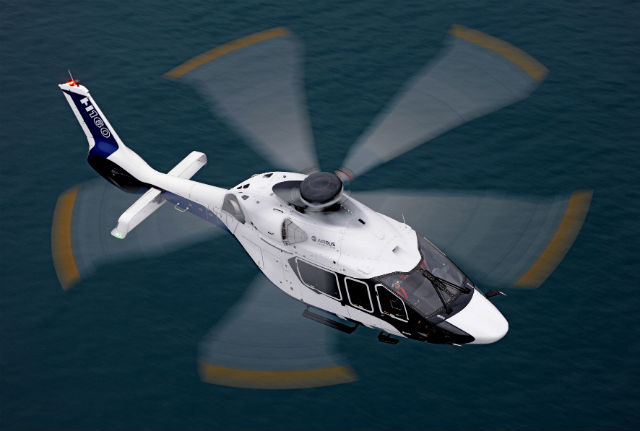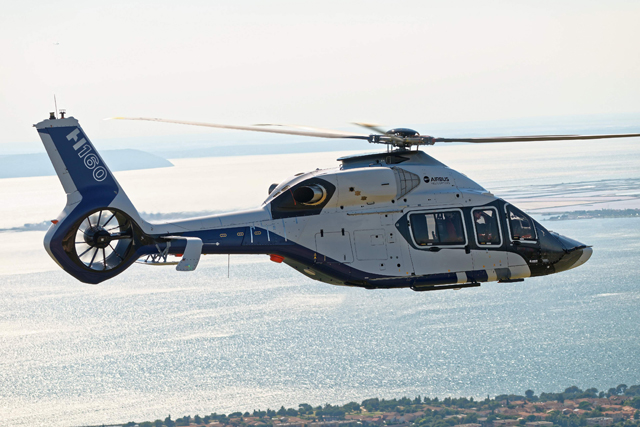“This is a very important milestone for us,” says Bernard Fujarski, head of the H160 programme at Airbus Helicopters.
“To be able to freeze the aero-mechanical configuration is really an achievement and we are very proud of what we have reached and what the team has made because it goes beyond our expectations and specification, especially on vibration.”
It has been relatively smooth progress on the H160 – billed by the manufacturer, in reference to the company’s rebranding, as the first of the H-generation – since the medium twin was launched in March 2015.
It has successfully transitioned from extensive rig testing, moved to flight-test status and had its configuration frozen – announced on 28 July – in about 18 months.
“The serial design is now in our hands and that’s the result of development flights where we have tested and experimented with different kits,” Fujarski says.
Notable design features – including the canted fenestron tail rotor, hockey stick-shaped main rotorblades and rear biplane stabiliser – have all been validated, he says, plus a number of less visible tweaks such as modifications to the engine intakes and cowlings.
Certification trials are proceeding well, and the programme has now accumulated about 250h, with the two prototypes making three flights a day on average.
However, aircraft development programmes have a habit of creeping off schedule, and Airbus Helicopters has given its first hints that the H160 may be no exception.

Anthony Pecchi/Airbus Helicopters
Fujarski says certification and service entry may push back from the end of 2018 to early 2019 in order to “give priority to the maturity of the product and industrial process and have full readiness for the support environment”.
“It may require that we take some additional months and deliver the first aircraft not at the end of 2018 but a few months later in 2019,” he says.
The airframer has history here, having delayed the service entry of the H175 in 2013 to ensure similar readiness of support infrastructure.
Equally, with the helicopter having been pitched from launch squarely at the now crisis-hit oil and gas market, there is, Fujarski says, “no urgency” from that sector “to deliver rapidly”.
Although there are ongoing talks with the type’s undisclosed launch customer to find the “best compromise” for first delivery, it would not be a surprise to see that milestone move into 2019.
There also seems to have been a subtle shift in emphasis by the manufacturer, moving from a scenario where offshore transportation was seen as the first market for the H160, to a much more flexible outlook that encompasses offshore, onshore and emergency medical services.
So far, all that Airbus Helicopters will say about customers for the medium twin is that it has secured letters of intent (LoI) from both the “transportation” and VIP segments, which are the first two configurations in development.
“We have a number of LoIs signed at this stage. This is consistent with the production plan and the ramp up,” Fujarski says. The only disclosed customer is Abu Dhabi’s Falcon Aviation Services which is to acquire a VIP-roled example.

Airbus Helicopters
Three prototypes will be used for the certification effort – the third aircraft will join the fleet in early 2017, with the main fuselage to arrive at Airbus Helicopters’ Marignane site in southern France to begin final assembly in September this year.
A number of pre-serial (PS) examples will additionally be used for the approval process. Aircraft PS1 will be the first to be built on the H160’s bespoke production line, with the composite fuselage – built at the Airbus Helicopters facility in Donauwörth, Germany – due to be delivered in mid-2017.
Although the manufacturer intends to eventually produce the H160 on a takt flow line, aircraft 1-6 will be built on a static line, Fujarski says, as it attempts to “refine and validate the industrial process”.
The first to be produced on the moving line will be aircraft seven, with speed progressively increased from that point until reaching maximum capacity of 40 units per year from aircraft 12.
As well as validation of the airframe and dynamic components, a key aspect of the test effort will be confirmation of the performance of its 1,300shp (969kW) Safran Helicopter Engines Arrano powerplants.
“I cross my fingers because it is a brand new engine, but so far it has gone incredibly to plan: it is very successful – it has passed all the milestones so far,” Fujarski says.
The engine manufacturer wrapped up bench tests at its Bordes, France site at the end of July, Fujarski says, and the results from these trials will be used to correctly calibrate engines to be flown from September. Assuming everything conforms to plan, this will enable Airbus Helicopters to provide precise performance data to the market late this year or early next year.
Those performance characteristics should prove to be the last piece of the jigsaw; the airframer has so far declined to detail the maximum take-off weight of the H160, describing it only as a “5.5t to 6t” helicopter.
Source: FlightGlobal.com


























